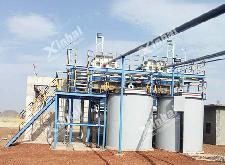

Warm Tip: If you want to know more details about equipment, solutions, etc, please click the button below for free consultation, or leave your requirements!
In gold cyanidation plant, there are 3 main processes for extracting gold from the leaching solution: zinc replacement process, activated carbon adsorption process and ion exchange resin process. This article will briefly introduce these 3 processes to you.
Using zinc powder, zinc flakes or zinc wire to replace gold and silver from the leaching solution. The reaction equation is:
2NaAu(CN) ₂+Zn→NaZn(CN) ₄+2Au↓
The zinc replacement process consists of 4 operations: leachate washing and purification, deoxidation, displacement precipitation, and smelting.
Step1 Washing
Before replacing the sedimentation, perform sedimentation treatment or filtration on the leachate to make it free of mud or colloidal substances.
Step2 Deoxygenation
Use vacuum extraction to remove dissolved oxygen in the leaching solution to avoid zinc oxidation.
Step3 Precipitation displacement
Replace the gold and silver in the leaching solution with zinc to form gold (silver) mud.
Step4 Smelting
Gold mud is smelted and ingots after removing impurities.

(Flow chart of gold extraction with zinc replacement process)
The zinc replacement method is a relatively mature cyanidation process. However, the process flow is complicated, the technical requirements are stricter, the operation is more complicated, and the equipment investment and production costs are high. It is not fitful for oxidized ore with high mud content and ore with difficult solid-liquid separation and low washing rate. This process is suitable for processing gold ore with high silver content because it can effectively recover silver.
Using activated carbon to recover gold from leaching solution. The dissolved gold in the leaching solution is adsorbed in the form of ion pairs, anions and common cyanide ions to obtain gold-loaded carbon. The gold-loaded carbon is desorbed and electrolyzed to obtain gold mud.
The activated carbon adsorption process consists of 4 operations: activated carbon adsorption, gold-loaded carbon desorption, electrowinning and electrolysis, smelting and activated carbon regeneration.
Step1 Activated carbon adsorption
In the CIP process, it is leached first and then adsorbed. The leaching solution is transported to an adsorption tank, where activated carbon is added for adsorption to obtain gold-loaded carbon.
In the CIL process, it is different from CIP, the gold is absorbed while being leached. Generally, the first two leaching tanks are used for leaching operations, and activated carbon is added to the remaining tanks for leaching and adsorption.
Step2 Gold-loaded carbon desorption electrolysis
The gold-loaded carbon is desorbed under the conditions of high concentration of cyanide and alkali, and the desorbed solution is used to obtain precipitated gold by electrowinning.
Step3 Smelting
After pickling and impurity removal, the obtained gold mud can be directly smelted into gold ingots.
Step4 Activated carbon regeneration
After desorption, there will be some impurity ions on the surface of activated carbon that will affect its adsorption activity. The thermal regeneration method is usually used to oxidize and decompose organic matter, or to carbonize impurities that are difficult to decompose, so that activated carbon can regain adsorption capacity.

(Flow chart of gold extraction with activated carbon adsorption process)
Compared with the zinc replacement process, the activated carbon adsorption process has many advantages: strong adaptability, simple procedures, low investment, low cost, higer recovery rate and higher quantity.
However, the activated carbon adsorption process is not suitable for processing gold ores with high silver content and high-grade gold concentrates.
During cyanide leaching, the gold and silver in the pulp are both in the form of cyanide complex anions Au(CN) ²¯ and Ag(CN) ²¯. Add resin to the solution, and the anion in the resin will exchange with Au(CN) ²¯ and Ag(CN) ²¯ anions to achieve the recovery of gold and silver.
The ion exchange resin adsorption process consists of 4 operations: resin adsorption, gold-loaded resin desorption and electrolysis, smelting ingot making and resin regeneration.
Step1 Resin adsorption
After the slurry is stirred and pre-soaked, the resin is added and adsorbed while leaching. The resin and the slurry move in countercurrent, and the gold-loaded resin is regularly and quantitatively extracted in the first adsorption tank.
Step2 Gold-loaded resin desorption electrolysis
The gold-loaded resin is desorbed under normal temperature and pressure using ammonium hydrosulfide and sodium hydroxide. The pregnant obtained by desorption is electroplated to obtain precipitated gold.
Step3 Smelting
The gold mud is acid and impurity removed, and the obtained gold mud can be directly smelted into gold ingots.
Step4 Resin regeneration
The de-gold resin is soaked in dilute hydrochloric acid and alkali solution for 12 hours at room temperature, then the soaking liquid is drained, the resin is washed to neutrality with clear water, and the resin can be recycled.
The ion exchange resin gold extraction process is suitable for processing various types of gold ore. It is especially suitable for processing the ore with high mud content and can not be filtered by cyanide leaching. The technological process is simple, the capital construction investment is small, the production cost is low, the adsorption speed is fast, and the adsorption capacity is high. But the disadvantage is that the resin has poor adsorption selectivity for gold, and its application is not yet mature.
The above is an introduction to the zinc replacement process, activated carbon adsorption process and ion exchange resin process. At present, the most widely used is the activated carbon adsorption process, because the comprehensive recovery index of gold is better, the process flow is simple, and the investment and cost are relatively low. When dealing with gold ore with high silver content, zinc replacement process is recommended. When dealing with gold ore with high mud content, resin adsorption process is recommended.
Last: 9 Important Processes of Pool Leaching
Next: Process Quality Management of Gold CIP Plant Explained
1Process Quality Management of Gold CIP Plant Explained
 0
0
 3203
3203
2How to Improve the Effect of Gold Cyanidation Process

 3934
3934
3Difficulties and Solutions in Micro-fine Gold Extraction?
 0
0
 3222
3222


What Are the Differences Between CIP and CIL?
 10152
10152
 0
0